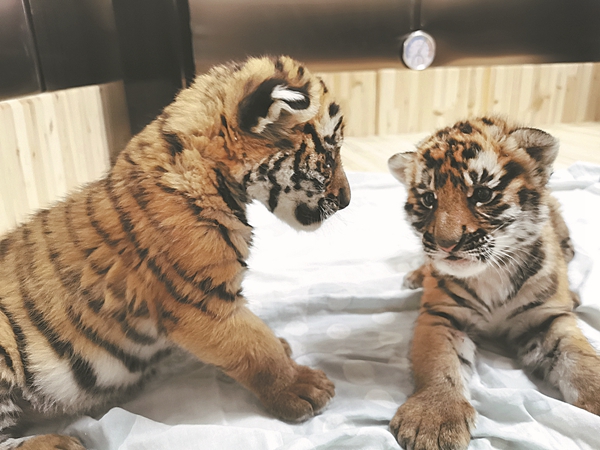South China tigers claw way back from brink
 0 Comment(s)
0 Comment(s) Print
Print E-mail China Daily, September 20, 2022
E-mail China Daily, September 20, 2022

A pair of female South China tigers named Mengmeng and Meimei are expected to mate later this year at a breeding center in Shaoguan in the north of Guangdong province, as part of attempts to increase the population of the endangered species.
Meimei turned three in July and Mengmeng gave birth to twin female cubs, Lianhua and Furong, at the end of last year, according to Lei Shengqiao, chief keeper at the South China Tiger Breeding Center.
After starting out with only two of the big cats when it was founded in 2008, the center is now home to 14 South China tigers, including six females and eight males, nine of which are adults.
A native species, the South China tigers once inhabited a vast region that stretched between Sichuan province to the west, Zhejiang to the east, Henan province to the north and the Guangxi Zhuang autonomous region to the south.
There were around 10,000 South China tigers in the early 1950s but the animals had not been spotted in the wild since the 1990s as a result of hunting and environmental damage.
There were 246 South China tigers in captivity across the country last year. The species is one of the 10 most endangered in the country, and has been placed under the strictest protection. The South China Tiger Nature Reserve, which was established in northern Guangdong in 1990, later founded the 30-hectare breeding center.
In addition to the twins, the center welcomed two more newborns-Yuanyuan and Qingqing-last year.
The limited population creates genetic problems arising from the relatively high degree of inbreeding, which poses a challenge to efforts to expand the tiger population, according to Gong Zhihai, director of the management office of the nature reserve and the breeding center.
Caring for the big cats is not easy. Adults eat the equivalent of 7 to 8 percent of their body mass per day in a single meal, with strict diets observed on Tuesdays and Fridays to help them maintain their form and health, Lei said.
Cubs eat two to three meals a day, with their diets adjusted according to their ability to chew and digest.
For Lei, one of the most memorable moments followed the birth of Weiwei, the first cub born to the first two tigers at the center, Prince and Princess, who came down with pneumonia.
"He was barely moving, apart from his belly rising and falling faintly. I was so worried. I reported the case and veterinarians quickly came to check on him," Lei said. "I stayed at the center for a month looking after him. He is the one I have spent the most time with."
Thanks to funding from the Shenzhen Project Care Foundation, facilities at the center are being upgraded.
The center is also working to create a 333-hectare space that will focus on breeding and reintroducing tigers to the wild.
A part of the nature reserve falls under the new Nanling National Park, which is due for completion in 2025.
The Nanling area is ideally suited to South China tigers and the national park will also help address issues surrounding the protection of biodiversity, Gong said.






Go to Forum >>0 Comment(s)